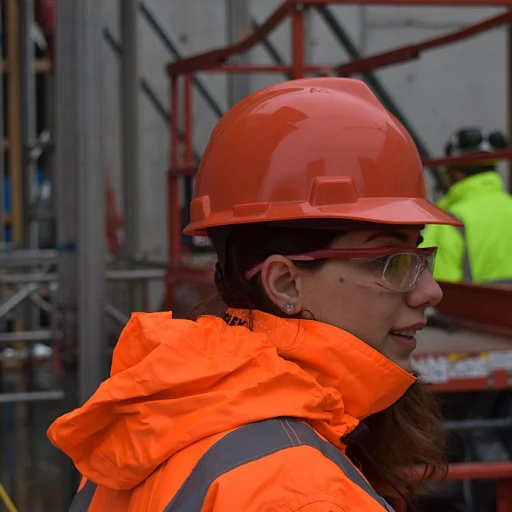
Understanding the Concept of an Intelligent Workplace
Grasping the Essence of Intelligent Workspaces
In today's rapidly evolving work environment, the notion of an intelligent workplace has garnered much attention. But what does it truly entail? At its core, an intelligent workplace leverages a combination of advanced technologies and data-driven insights to create a more efficient, collaborative, and engaging work environment for employees. These workspaces are not just about digital tools and systems; they are about enhancing the overall employee experience and productivity. The concept revolves around the integration of smart solutions that simplify tasks and foster hybrid work scenarios, ensuring that both in-office and remote employees can work seamlessly. With the rise of workplace technology, including cloud computing, machine learning, and artificial intelligence, organizations are now better equipped to make real-time decisions that enhance their daily operations. Furthermore, tools like booking software and data analytics play a crucial role in managing resources efficiently and ensuring optimal productivity. Data is the backbone of intelligent workplaces, driving decision-making and enabling companies to adapt quickly to changes in the work environment. It helps in understanding employee behaviors, preferences, and engagement levels, ultimately contributing to a healthier workplace culture. By exploring sentiment analysis trends in HR, organizations can tap into the emotional and cognitive actions of their workforce, creating a more responsive and inclusive environment. In essence, an intelligent workspace goes beyond the conventional office setup. It's about creating a flexible and dynamic environment that prioritizes human intelligent interactions and uses technology as a catalyst for growth and innovation.The Role of Human Resources Analytics
How HR Analytics Shapes an Intelligent Workplace
In the era of the intelligent workplace, the role of human resources analytics cannot be understated. This powerful tool is reshaping the way businesses make decisions, enhancing productivity, and transforming the employee experience. As workplaces become more digital, companies that harness the potential of human resources analytics stand to benefit by creating smarter, more efficient systems.
Human resources analytics utilizes data-driven insights to help organizations make informed decisions about their workforce. By analyzing employee data, companies can identify trends, measure performance, and anticipate future needs. This data-driven decision-making process allows organizations to optimize their resources, improving overall productivity and employee engagement.
The integration of workplace technology, such as digital tools and cloud computing, enables HR professionals to collect real-time data on employee performance and satisfaction. This information can be used to develop strategies for improving collaboration and boosting employee morale, ultimately leading to a more productive work environment.
Smart systems and machine learning technologies are also playing a pivotal role in the evolution of the intelligent workplace. By automating repetitive tasks and streamlining processes, these systems allow employees to focus on more strategic initiatives. It also allows human resources teams to concentrate on fostering a culture of continuous learning and development, crucial elements in an intelligent workspace.
As hybrid work models become the norm, the ability to adapt quickly to changing work environments has never been more important. HR analytics offers this flexibility by providing insights into which digital solutions and collaboration tools are best suited for maintaining productivity across both physical and digital workplaces.
It's essential to recognize the importance of employee engagement in building an intelligent workplace. With the right analytics tools, businesses can better understand the needs and preferences of their workforce, tailoring their strategies to enhance the overall employee experience. By creating an environment that values open communication and inclusivity, companies can ensure that their employees are fully engaged and motivated.
The strategic use of HR data analytics is undoubtedly a critical component in developing and maintaining an intelligent workplace. For more insights on how to effectively leverage analytics to unlock talent potential, visit our HR analytics blog.
Leveraging Technology for Enhanced Collaboration
Enhancing Team Dynamics through Technological Advances
An intelligent workplace is defined by its ability to blend human resources with technology, fostering collaboration and boosting productivity. In today's work environment, the surge of hybrid arrangements and digital tools has transformed how employees connect and engage. This shift calls for innovative solutions to manage and enhance collaboration within intelligent workplaces.
Leveraging workplace technology is pivotal for effective teamwork. Digital tools such as cloud computing and booking software facilitate seamless communication among employees, regardless of their physical location. These systems allow for real-time collaboration, ensuring that tasks are efficiently coordinated and executed.
Furthermore, the integration of artificial intelligence and machine learning in workplace systems is enhancing decision-making processes. By analyzing vast amounts of data, these technologies can provide actionable insights, enabling employees to make informed choices swiftly. This technological edge not only streamlines operations but also fosters a more intelligent workspace where human input is effectively augmented by smart systems.
Another critical aspect is the utilization of data analytics to improve employee experience and boost engagement. By capturing and analyzing employee feedback and performance metrics, companies can tailor interventions that enhance the overall work environment. These insights can be pivotal in designing strategies that support both productivity and employee satisfaction.
Ultimately, the use of technology in boosting collaboration is essential in creating a unified team dynamic. The harmonious blend of digital solutions with human resources defines an intelligent workplace, where collaboration is not merely a buzzword but a vital component of organizational success.
Data-Driven Decision Making in HR
Data-Driven HR Decision Making: Transforming the Workplace
In today's fast-paced business environment, the use of data analytics in HR is revolutionizing how workplaces operate. With workplaces becoming more digital and hybrid, HR professionals are increasingly reliant on data-driven decision-making processes. This approach involves utilizing a wide range of data—from employee performance metrics to workplace technology usage—to make informed HR decisions that enhance productivity and employee engagement. The integration of intelligent systems and data analytics has paved the way for more informed HR strategies. By leveraging digital tools, organizations can effectively navigate the complexities of a hybrid work environment. One key aspect of this transformation is the ability to access real-time data on employees' workflow and collaboration patterns, allowing businesses to adapt swiftly to changing conditions. This is where the power of artificial intelligence and machine learning comes into play, offering predictive insights that guide strategy and planning. Moreover, data analytics helps HR departments to identify areas that need improvement and innovation. By continuously assessing workplace data, HR can pinpoint bottlenecks in productivity and take steps to address them. This can include introducing smart tools that facilitate seamless communication and collaboration among team members, whether they're working from the office or remotely. In essence, the intelligent use of data analytics enables decision-makers to craft strategies that not only improve the employee experience but also foster a culture of continuous learning. By prioritizing data-driven approaches, companies are better equipped to support meaningful work and create a thriving intelligent workplace environment.Creating a Culture of Continuous Learning
Fostering a Dynamic Work Environment Through Continuous Learning
Creating a culture that values continuous learning is essential for establishing an intelligent workplace. This involves not only using data analytics and technology to enhance productivity but also ensuring that employees have the necessary tools and resources to grow and adapt in an evolving digital workplace.
By integrating collaborative technologies, such as cloud computing and digital tools, organizations can streamline their learning processes and enable employees to access training and educational resources anytime and anywhere. This hybrid approach to learning bridges the gap between traditional and modern workplaces, enhancing the employee experience.
Incorporating smart systems and machine learning into training modules allows for more personalized learning experiences. These systems can analyze data to understand individual learning preferences and offer tailored recommendations. This not only increases employee engagement but also enables the workforce to develop skills that are aligned with organizational goals.
Moreover, a workplace that emphasizes continuous learning empowers employees to take charge of their own development. This proactive attitude can lead to improved collaboration, higher productivity, and a more innovative work environment. By investing in the ongoing education of employees, companies can harness human intelligent capabilities that directly contribute to the office's success as well as the organization's overall objectives.
As businesses adopt intelligent workplace practices, they must ensure that their strategies for continuous learning are measured effectively. Implementing data-driven decision-making processes is crucial to understanding the impact of these learning initiatives and making informed adjustments as needed.
Measuring the Success of an Intelligent Workplace
Evaluating the Effectiveness of an Intelligent Work Environment
Determining whether an intelligent workplace truly delivers on its promises involves multiple facets. To gauge this success, organizations can rely on a combination of quantitative and qualitative metrics. First, leveraging data analytics is key. This involves measuring employee productivity through digital tools and systems, tracking collaboration efficiency with real-time data, and analyzing overall employee engagement levels.
- Productivity Metrics: Tools like cloud computing and digital workplace solutions enable the collection and analysis of performance data. Metrics such as task completion rates, project turnaround times, and output quality are valuable indicators of workplace intelligence.
- Engagement Scores: Employee surveys, feedback mechanisms, and engagement platforms provide insights into employee satisfaction and morale. High engagement scores often correlate with a well-functioning intelligent office.
- Collaboration Efficiency: With technologies designed to enhance workplace collaboration, such as booking software and communication platforms, organizations can assess how effectively employees work together in both physical and hybrid work models.
- Technology Utilization: The degree to which employees adopt and effectively use intelligent workplace technologies is another indicator of success. High usage rates of digital tools suggest successful integration and value.
- Continuous Learning Indicators: A culture of continuous learning can be assessed through participation in training programs, uptake of learning solutions, and skill enhancement initiatives.
By keeping these metrics in focus, workplaces can ensure that their intelligent systems and practices continually align with their goals, driving both efficiency and employee satisfaction. Ultimately, measuring the success of an intelligent workplace goes beyond simple figures; it requires a comprehensive view of how technology enhances the work environment and overall employee experience.












